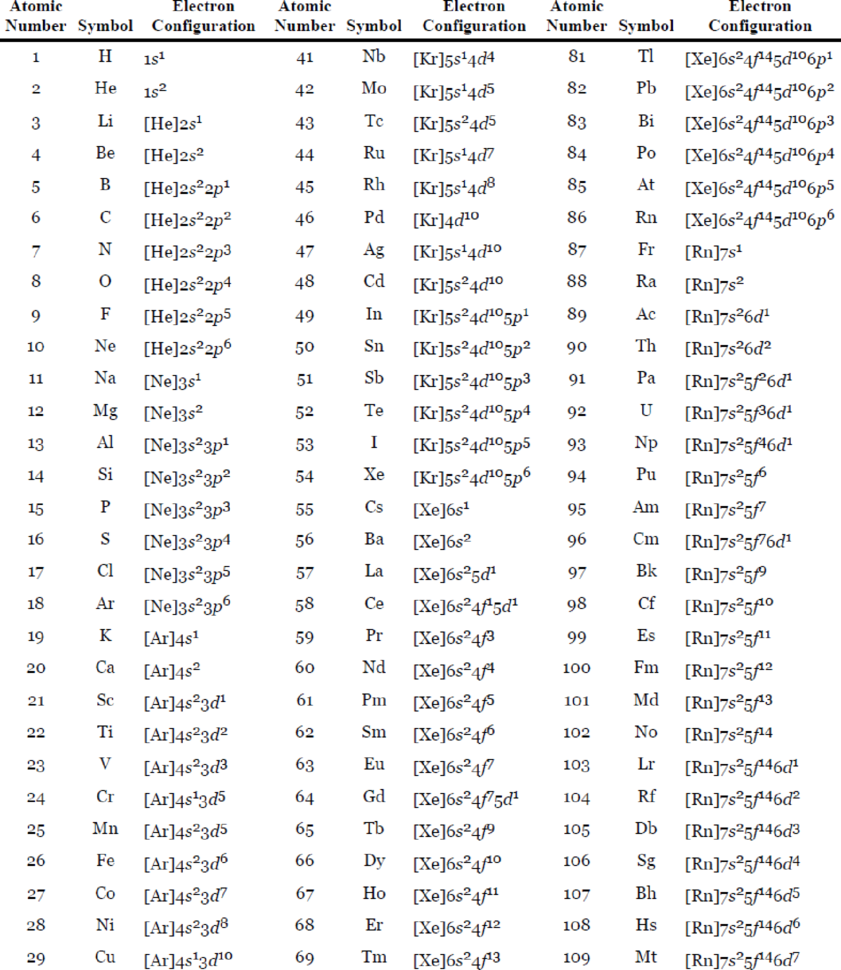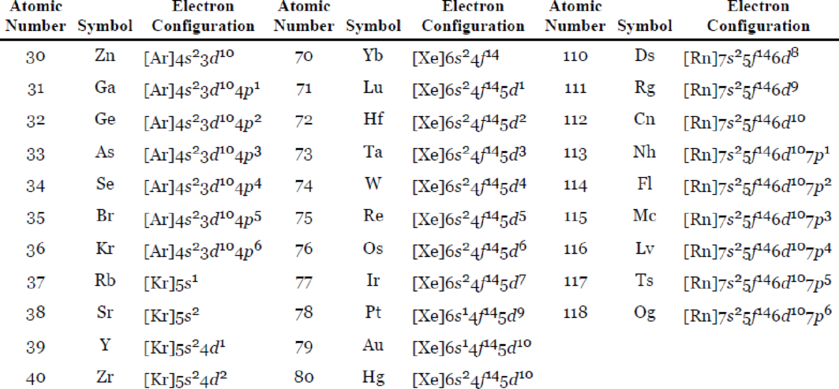
CHEMISTRY 1111 LAB MANUAL >C<
1st Edition
ISBN: 9781307092097
Author: Chang
Publisher: MCG/CREATE
expand_more
expand_more
format_list_bulleted
Textbook Question
Chapter 23.1, Problem 1RC
Identify the following
Table 7.3 The Ground-State Electron Configurations of the Elements*


Expert Solution & Answer
Trending nowThis is a popular solution!

Students have asked these similar questions
NMR spectrum of ethyl acetate has signals whose chemical shifts are indicated below. Which hydrogen or set of hydrogens corresponds to the signal at
4.1 ppm? Select the single best answer.
The
H
O
HỌC—C—0—CH, CH,
2
A
ethyl acetate
H NMR: 1.3 ppm, 2.0 ppm, 4.1 ppm
Check
OA
B
OC
ch
B
C
Save For Later
Submit Ass
© 2025 McGraw Hill LLC. All Rights Reserved. Terms of Use | Privacy Center |
How many signals do you expect in the H NMR spectrum for this molecule?
Br Br
Write the answer below.
Also, in each of the drawing areas below is a copy of the molecule, with Hs shown. In each copy, one of the H atoms is colored red. Highlight in red all other H
atoms that would contribute to the same signal as the H already highlighted red
Note for advanced students: In this question, any multiplet is counted as one signal.
1
Number of signals in the 'H NMR spectrum.
For the molecule in the top drawing area, highlight in red any other H atoms that will contribute to
the same signal as the H atom already highlighted red.
If no other H atoms will contribute, check the box at right.
Check
For the molecule in the bottom drawing area, highlight in red any other H atoms that will contribute
to the same signal as the H atom already highlighted red.
If no other H atoms will contribute, check the box at right.
O
✓
No additional Hs to color in top
molecule
ง
No additional Hs to color in bottom…
in the kinetics experiment, what were the values calculated? Select all that apply.a) equilibrium constantb) pHc) order of reactiond) rate contstant
Chapter 23 Solutions
CHEMISTRY 1111 LAB MANUAL >C<
Ch. 23.1 - Identify the following transition metal atoms and...Ch. 23.3 - What is the difference between these two...Ch. 23.3 - Write the oxidation numbers of the metals in the...Ch. 23.3 - Prob. 2PECh. 23.3 - Prob. 3PECh. 23.3 - Prob. 2RCCh. 23.4 - Prob. 1RCCh. 23.5 - Prob. 4PECh. 23.5 - Prob. 1RCCh. 23 - What distinguishes a transition metal from a...
Ch. 23 - Why is zinc not considered a transition metal?Ch. 23 - Explain why atomic radii decrease very gradually...Ch. 23 - Without referring to the text, write the...Ch. 23 - Write the electron configurations of the following...Ch. 23 - Why do transition metals have more oxidation...Ch. 23 - Prob. 23.7QPCh. 23 - Prob. 23.8QPCh. 23 - Define the following terms: coordination compound,...Ch. 23 - Describe the interaction between a donor atom and...Ch. 23 - Prob. 23.11QPCh. 23 - Prob. 23.12QPCh. 23 - Prob. 23.13QPCh. 23 - Prob. 23.14QPCh. 23 - Prob. 23.15QPCh. 23 - What are the systematic names for the following...Ch. 23 - Prob. 23.17QPCh. 23 - Prob. 23.18QPCh. 23 - Define the following terms: stereoisomers,...Ch. 23 - Prob. 23.20QPCh. 23 - Prob. 23.21QPCh. 23 - Prob. 23.22QPCh. 23 - Prob. 23.23QPCh. 23 - Prob. 23.24QPCh. 23 - Draw structures of all the geometric and optical...Ch. 23 - Prob. 23.26QPCh. 23 - Briefly describe crystal field theory.Ch. 23 - Prob. 23.28QPCh. 23 - What is the origin of color in a coordination...Ch. 23 - Prob. 23.30QPCh. 23 - Prob. 23.31QPCh. 23 - Prob. 23.32QPCh. 23 - Prob. 23.33QPCh. 23 - Prob. 23.34QPCh. 23 - Prob. 23.35QPCh. 23 - The absorption maximum for the complex ion...Ch. 23 - Prob. 23.37QPCh. 23 - A solution made by dissolving 0.875 g of...Ch. 23 - Prob. 23.39QPCh. 23 - Prob. 23.40QPCh. 23 - Prob. 23.41QPCh. 23 - The [Fe(CN)6]3 complex is more labile than the...Ch. 23 - Aqueous copper(II) sulfate solution is blue in...Ch. 23 - When aqueous potassium cyanide is added to a...Ch. 23 - A concentrated aqueous copper(II) chloride...Ch. 23 - Prob. 23.46QPCh. 23 - As we read across the first-row transition metals...Ch. 23 - Prob. 23.48QPCh. 23 - Prob. 23.49QPCh. 23 - Prob. 23.50QPCh. 23 - Prob. 23.51QPCh. 23 - Chemical analysis shows that hemoglobin contains...Ch. 23 - Explain the following facts: (a) Copper and iron...Ch. 23 - A student in 1895 prepared three coordination...Ch. 23 - Prob. 23.55QPCh. 23 - From the standard reduction potentials listed in...Ch. 23 - Using the standard reduction potentials listed in...Ch. 23 - The Co2+-porphyrin complex is more stable than the...Ch. 23 - Prob. 23.59QPCh. 23 - Prob. 23.60QPCh. 23 - Hydrated Mn2+ ions are practically colorless (see...Ch. 23 - Which of the following hydrated cations are...Ch. 23 - Prob. 23.63QPCh. 23 - Prob. 23.64QPCh. 23 - Prob. 23.65QPCh. 23 - Prob. 23.66QPCh. 23 - The compound 1,1,1-trifluoroacetylacetone (tfa) is...Ch. 23 - Prob. 23.68QPCh. 23 - Prob. 23.69QPCh. 23 - Prob. 23.70QPCh. 23 - Prob. 23.71QPCh. 23 - Commercial silver-plating operations frequently...Ch. 23 - Draw qualitative diagrams for the crystal field...Ch. 23 - (a) The free Cu(I) ion is unstable in solution and...Ch. 23 - Prob. 23.75QPCh. 23 - Prob. 23.76QP
Knowledge Booster
Learn more about
Need a deep-dive on the concept behind this application? Look no further. Learn more about this topic, chemistry and related others by exploring similar questions and additional content below.Similar questions
- true or false, given that a 20.00 mL sample of NaOH took 24.15 mL of 0.141 M HCI to reach the endpoint in a titration, the concentration of the NaOH is 1.17 M.arrow_forwardin the bromothymol blue experiment, pKa was measured. A closely related compound has a Ka of 2.10 x 10-5. What is the pKa?a) 7.1b) 4.7c) 2.0arrow_forwardcalculate the equilibrium concentration of H2 given that K= 0.017 at a constant temperature for this reaction. The inital concentration of HBr is 0.050 M.2HBr(g) ↔ H2(g) + Br2(g)a) 4.48 x 10-2 M b) 5.17 x 10-3 Mc) 1.03 x 10-2 Md) 1.70 x 10-2 Marrow_forward
- true or falsegiven these two equilibria with their equilibrium constants:H2(g) + CI2(l) ↔ 2HCI(g) K= 0.006 CI2(l) ↔ CI2(g) K= 0.30The equilibrium contstant for the following reaction is 1.8H2(g) + CI2 ↔ 2HCI(g)arrow_forwardI2(g) + CI2(g) ↔ 2ICIK for this reaction is 81.9. Find the equilibrium concentration of I2 if the inital concentration of I2 and CI2 are 0.010 Marrow_forwardtrue or false,the equilibrium constant for this reaction is 0.50.PCI5(g) ↔ PCI3(g) + CI2(g)Based on the above, the equilibrium constant for the following reaction is 0.25.2PCI5(g) ↔. 2PCI3(g) + 2CI2(g)arrow_forward
- true or false, using the following equilibrium, if carbon dioxide is added the equilibrium will shift toward the productsC(s) + CO2(g) ↔ 2CO(g)arrow_forward2S2O2/3- (aq) + I2 (aq) ---> S4O2/6- (aq) +2I- (aq) Experiment I2 (M) S2O3- (M) Initital Rate (M/s) 1 0.01 0.01 0.0004 2 0.01 0.02 0.0004 3 0.02 0.01 0.0008 Calculate the overall order for this reaction using the table data a) 3b) 0c) 2d) 1arrow_forwardthe decomposition of N2O5 is the first order with a half-life of 1.98 minutes. If the inital concentration of N2O5 is 0.200 M, what is the concentration after 6 minutes?a) 0.612 Mb) 0.035 Mc) 0.024 Md) 0.100 Marrow_forward
- 20.00 mL of 0.150 M HCI is titrated with 0.075 M NaOH. What volume of NaOH is needed?a) 50 mLb) 20 mLc) 40 mLd) 26.66 mLarrow_forward20.00 mL of 0.150 M NaOH is titrated with 37.75 mL of HCI. What is the molarity of the HCI?a) 0.150 Mb) 0.079 Mc) 0.025 Md) 0.050 Marrow_forwardin the following reaction, the OH- acts as which of these?NO2- (aq) + H2O (l) ⇌ OH- (aq) + HNO2 (aq)a) not a weak acidb) basec) acidarrow_forward
arrow_back_ios
SEE MORE QUESTIONS
arrow_forward_ios
Recommended textbooks for you
 ChemistryChemistryISBN:9781305957404Author:Steven S. Zumdahl, Susan A. Zumdahl, Donald J. DeCostePublisher:Cengage Learning
ChemistryChemistryISBN:9781305957404Author:Steven S. Zumdahl, Susan A. Zumdahl, Donald J. DeCostePublisher:Cengage Learning Chemistry: An Atoms First ApproachChemistryISBN:9781305079243Author:Steven S. Zumdahl, Susan A. ZumdahlPublisher:Cengage Learning
Chemistry: An Atoms First ApproachChemistryISBN:9781305079243Author:Steven S. Zumdahl, Susan A. ZumdahlPublisher:Cengage Learning
 Chemistry & Chemical ReactivityChemistryISBN:9781337399074Author:John C. Kotz, Paul M. Treichel, John Townsend, David TreichelPublisher:Cengage Learning
Chemistry & Chemical ReactivityChemistryISBN:9781337399074Author:John C. Kotz, Paul M. Treichel, John Townsend, David TreichelPublisher:Cengage Learning Chemistry: The Molecular ScienceChemistryISBN:9781285199047Author:John W. Moore, Conrad L. StanitskiPublisher:Cengage Learning
Chemistry: The Molecular ScienceChemistryISBN:9781285199047Author:John W. Moore, Conrad L. StanitskiPublisher:Cengage Learning Chemistry & Chemical ReactivityChemistryISBN:9781133949640Author:John C. Kotz, Paul M. Treichel, John Townsend, David TreichelPublisher:Cengage Learning
Chemistry & Chemical ReactivityChemistryISBN:9781133949640Author:John C. Kotz, Paul M. Treichel, John Townsend, David TreichelPublisher:Cengage Learning

Chemistry
Chemistry
ISBN:9781305957404
Author:Steven S. Zumdahl, Susan A. Zumdahl, Donald J. DeCoste
Publisher:Cengage Learning

Chemistry: An Atoms First Approach
Chemistry
ISBN:9781305079243
Author:Steven S. Zumdahl, Susan A. Zumdahl
Publisher:Cengage Learning


Chemistry & Chemical Reactivity
Chemistry
ISBN:9781337399074
Author:John C. Kotz, Paul M. Treichel, John Townsend, David Treichel
Publisher:Cengage Learning

Chemistry: The Molecular Science
Chemistry
ISBN:9781285199047
Author:John W. Moore, Conrad L. Stanitski
Publisher:Cengage Learning

Chemistry & Chemical Reactivity
Chemistry
ISBN:9781133949640
Author:John C. Kotz, Paul M. Treichel, John Townsend, David Treichel
Publisher:Cengage Learning
Introduction to Coordination ComplexesWave Function for Hydrogen atom # All Vital Topics # Quantum Mechanics part -21; Author: Priyanka Jain;https://www.youtube.com/watch?v=GKgNV9dmUHo;License: Standard YouTube License, CC-BY
CBSE Class 12 Chemistry || The d & f Block Elements Part 1 || Full Chapter || By Shiksha House; Author: Best for NEET;https://www.youtube.com/watch?v=LzZWHSdYaxw;License: Standard Youtube License